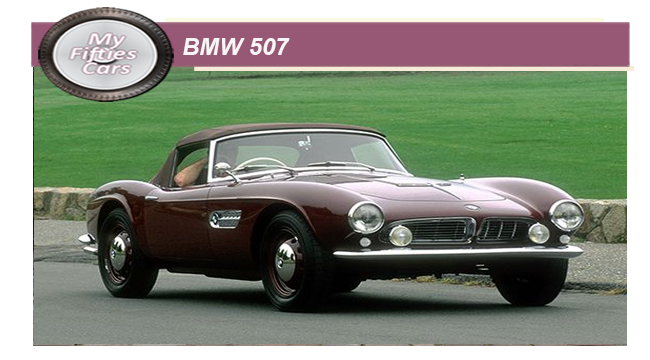 In an almost desperate attempt to recover from the commercial failures of the 501 and 502, BMW began to attempt to develop their US market.
In an almost desperate attempt to recover from the commercial failures of the 501 and 502, BMW began to attempt to develop their US market.
To do so BMW turned to designer Albrecht von Goertz to develop two new models, largely according to the specifications of Max Hoffman, a leading East Coast auto importer.
H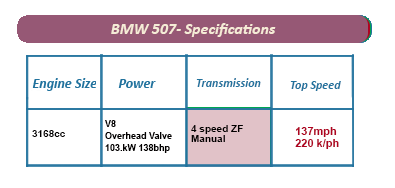 offman's prompting led initially to the development of the BMW 503 and later the 507, produced by BMW from 1956 to 1959.
offman's prompting led initially to the development of the BMW 503 and later the 507, produced by BMW from 1956 to 1959.
The BMW 507 made its debut at the Waldorf-Astoria Hotel in New York in the summer of 1955, once again to positive critical appraisal, with a few global celebrities rushing to snap one up ahead of the anticipated rush wish, Elvis Presley even adding two for his collection.
T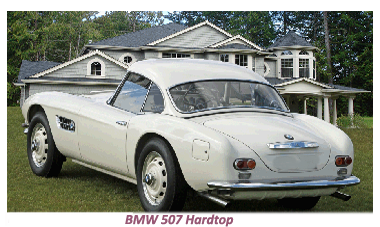 he initial response added weight to Hoffman's projections that these cars would sell like hot potatoes in the United States, with estimated sales running at the rate of thousands annually.
he initial response added weight to Hoffman's projections that these cars would sell like hot potatoes in the United States, with estimated sales running at the rate of thousands annually.
A welcome far cry from the few hundred models that BMW had been selling every year since the launch of the 501 in 1951.
The 503 and 507 were powered by BMW's 3.2-litre aluminium alloy overhead-valve eight-cylinder engine, coupled with four-speed manual transmission.
![]()
Hoffman's vision was that these cars would fit very nicely into a niche between and the inexpensive but underpowered MG and Triumph imported from the UK and the super robust and powerful Mercedes sports that commanded a very substantial price in the US.
The early 507's failed to impress US buyers, which, although it was more powerful than the UK imports, it was not sufficiently so to demand the still considerable price tag that Hoffman was asking.
F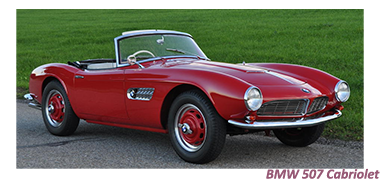 eedback from buyers and distributors soon began to indicate that the problem stemmed from the 507's disproportionately large fuel tanks, which could hold 110 litres (29 US gallons) when full, slowing down the car.
eedback from buyers and distributors soon began to indicate that the problem stemmed from the 507's disproportionately large fuel tanks, which could hold 110 litres (29 US gallons) when full, slowing down the car.
 Apart from the extra weight, the tanks also limited the boot and rear-seat passenger space, making for a particularly uncomfortable driving experience.
Apart from the extra weight, the tanks also limited the boot and rear-seat passenger space, making for a particularly uncomfortable driving experience.
Made aware of the problem, BMW soon came up with a smaller tank, holding just 66 litres, allowing the car to travel faster and freeing up boot and passenger space.
However, the flying start that BMW anticipated failed to transpire, with the 502 proving to be an even damper squib than its predecessors.
Despite its lack of commercial success, the 507 earned its place in the history of the Fifties as a leading example of a "classic" sports car,in terms of both style and technology.
![]()
Even sportier than the 503, the two-seat roadster was built on a considerably shorter wheelbase (only 97.6 inches, versus 111.6 inches for the 503).
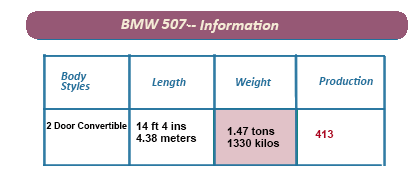 The 507 stood out because of its angled air-intake grilles on each cowl, offsetting a round BMW emblem at their rear (reminiscent of the recently released "gullwing" Mercedes 300SL.In place of the now customary narrow "twin-kidney" grille, the 507's froחt end displayed two wide separated openings, each with horizontal strips and vertical dividers, while the hood showed a slight bulge, with the BMW emblem ahead of it.
The 507 stood out because of its angled air-intake grilles on each cowl, offsetting a round BMW emblem at their rear (reminiscent of the recently released "gullwing" Mercedes 300SL.In place of the now customary narrow "twin-kidney" grille, the 507's froחt end displayed two wide separated openings, each with horizontal strips and vertical dividers, while the hood showed a slight bulge, with the BMW emblem ahead of it.
As was the case with the 503, the factor that mainly chased off US potential buyers was the 507's price tag.
A price tage considered too high to guarantee substantial sales.
Despite its commercial failure, the 507 went on to become a milestone model thanks to its classic styling.

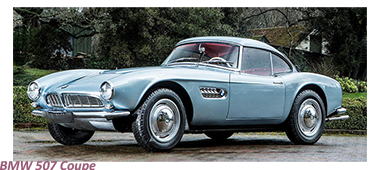 Of the 252 507s built in the three years that the car was in production,it is worthy of note that 202 are still around today.
Of the 252 507s built in the three years that the car was in production,it is worthy of note that 202 are still around today.
The occasional models that occasionally appear on the luxury auction circuits of the World command prices running into millions of dollars.
Ironic when you consider that BMW proudly claimed that they lost money on every 507 that they sold.



